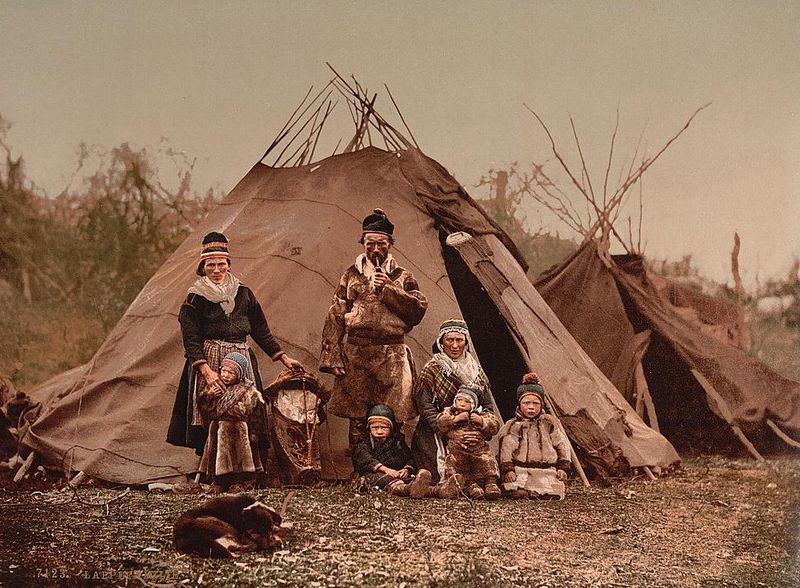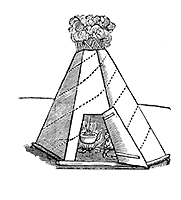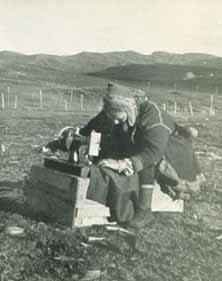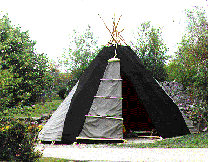A Short History of the Lavvu

A Powerful Cultural Symbol...
 The lavvu has been an important and powerful symbol of the Sami people for thousands of years - and it is still today. During the Alta Dam Conflict from 1979 to early 1982 when the Sami fought against the Norwegian government to prevent a hydro-electric dam to be built on sacred Sami ground, the lavvu was a symbol of cultural sanctuary.
The lavvu has been an important and powerful symbol of the Sami people for thousands of years - and it is still today. During the Alta Dam Conflict from 1979 to early 1982 when the Sami fought against the Norwegian government to prevent a hydro-electric dam to be built on sacred Sami ground, the lavvu was a symbol of cultural sanctuary.
Even today The Sami municipality of Kautokeino in Norway has a lavvu in its coat-of-arms.


Thousands of years ago...
It is impossible to state with any certainty when the Sami first used the Lavvu since they left no written records until the nineteenth century. However, it is known from Sami oral tradition that the lavvu design had been used for well over a thousand years. The drawing to the left is from Scheffer's History of Lapland printed in 1674 and is one of the earliest known Western representations of a lavvu. If one compares this drawing to the present day lavvu on this web site, very little has changed over the centuries. The only major changes were the material used for the cover.


Making thread - Reindeer gut...
For centuries, the Sami made their lavvus from reindeer hides, sewing them together into a large cover for the pole structure. Each of the hides was sewn together using reindeer gut as thread. The photo shown here is one way that the gut was worked into the thread. To this day, the Nenets and Khants of northern Russia continue to make their Lavvus - which they call them chums (CHOO-ms) of reindeer hides.
With the introduction of mass-produced English textiles during the Industrial Revolution, the Sami acquired canvas and other material through barter trade from the early nineteenth century onwards. The lavvu became more diverse in color but rarely diverting from the earth-tone natural color.

 Sewing on the tundra
Sewing on the tundra
The Industrial Revolution also brought new ways to construct a lavvu. For centuries, bone needles and gut thread laced the individual reindeer pelts into a uniform cover. But with the introduction of the hand-cranked sewing machine to northern Scandinavia during the late eight-teen hundreds, the construction of lavvus became completely reinvented.
Photo by Ernst Manker c.1932


The Lavvu today....
The lavvu is still used today used by the Sami of northern Scandinavia for both as a temporary shelter during the reindeer migrations and as a powerful cultural symbol of the Sami people.

Where can you see our Lavvus?

You can see one of our lavvus on permanent display at the IronWorld Discovery Center at Chisholm, Minnesota. This lavvu was built during the summer of 1997 and it's the largest one (known) in North America, at just over twenty feet in diameter.
The two-tone color is a recreation of pre-1900 Lavvus that were in common use at the time. This will give you some idea of what is possible with a Lavvu this size.
Our Lavvus have also been in the movie The Dark Forest - A film to be released during the summer of 2003. A mystery drama based on a true story about a Finnish/Sami family during World War Two. The lavvus shown in the movie were made by Northern Lavvu.
The Lavvu as a Sauna, Camping or Hunting Shelter
Because this structure can have an open campfire or wood stove inside, lavvus are very versatile with many different uses. Throwing water on a heated wood stove will create a sauna even in the middle of winter. Having an open campfire inside makes the lavvu cozy in winter and keeps out the dreaded mosquito during the summer.

| 